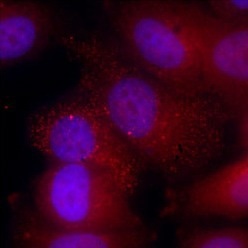Scientists claim that life does not come with an instruction manual, but this is not totally accurate. Each cell in our body follows the instructions provided by its DNA in the form of RNA molecules. RNA has lately been catapulted into the spotlight as the foundation of novel COVID-19 vaccines, but much essential understanding about this crucial molecule—for example, how it makes its way within the cell to a specific area—remains unknown.
 When the scientists blocked a protein that reads a zip code responsible for moving RNAs into the cytoplasm, numerous RNA molecules (bright dots) gathered instead in the cell nuclei (purple). Image Credit: Weizmann Wonder Wander.
When the scientists blocked a protein that reads a zip code responsible for moving RNAs into the cytoplasm, numerous RNA molecules (bright dots) gathered instead in the cell nuclei (purple). Image Credit: Weizmann Wonder Wander.
Researchers at the Weizmann Institute of Science have uncovered a cellular “postal code” system that ensures that RNA arrives at its destination on time.
Some RNAs remain in the nucleus to control gene expression, but the majority, particularly those carrying protein recipes, are destined for the cytoplasm, where proteins are synthesized. Previous investigations aimed at elucidating how RNAs get to their designated places yielded contradictory findings.
Some speculated that the information stored in the loose ends of the string-like, linear RNA molecules may control their paths. However, some RNAs are circular and, as a result, lack ends.
Other research discovered clues that specific short portions of RNA molecules may operate as zip codes, designating the neighborhood in the cell to which each RNA belongs; nevertheless, various studies relied on various zip codes, and there was little knowledge of how such zip codes would work.
Maya Ron and Prof. Igor Ulitsky of the Weizmann Institute of Science’s Immunology and Regenerative Biology and Molecular Neuroscience Departments used a method known as a “massively parallel RNA assay,” created in part in Ulitstky’s lab, to verify the zip code concept.
The technology allows researchers to investigate thousands of distinct RNAs at the same time, yielding findings in days rather than the years it would have previously taken to study these identical RNAs one at a time.
The researchers inserted thousands of distinct RNA segments into various “host” RNA molecules, either linear or circular, and then introduced copies into millions of cells. The researchers were able to determine the location of these RNAs after isolating the nucleus from the cytoplasm of these cells.
After examining over 8,000 genetic segments in this fashion, Ron and Ulitsky discovered that a few dozen of them do, in fact, function as zip codes. These zip codes command certain RNAs to remain in the nucleus, others to migrate into the cytoplasm right once, and yet others to do so only after staying in the nucleus for a time.
The researchers also uncovered many proteins that act as “postal clerks,” binding to RNAs, “read” their zip codes, and directed the RNAs to the places encoded there.
Surprisingly, this “postal system” clearly differentiated between linear and circular RNAs. To begin, depending on whether an RNA was linear or circular, the same zip code may allocate it to a different place. Furthermore, the sorting was done by two groups of postal clerks, one for linear RNAs and one for circular RNAs.
In reality, each clerk provided his or her own set of instructions. For example, one protein known as IGF2BP1 is mostly attached to linear RNAs, facilitating their export from the nucleus. Another, known as SRSF1, is responsible for guiding circular RNAs to remain in the nucleus. When the scientists inhibited the function of certain proteins, the RNAs processed by each of these postal clerks failed to reach their intended destinations throughout the cell.
These discoveries may be beneficial in creating RNA-based therapeutics, in addition to offering fresh insight into the functioning of the genome.
Many companies are now developing RNAs to be used as drugs or vaccines. Understanding how they get to their locations in the cell may help engineer artificial RNAs with desired properties. For example, if we want an RNA drug to make large amounts of a certain protein, it can be designed to spend most its time in the cytoplasm, where this protein can be produced.”
Prof. Igor Ulitsky, Department of Immunology and Regenerative Biology and Molecular Neuroscience, Weizmann Institute of Science
The study’s results might be especially useful for the usage of circular RNAs, which have just recently been the subject of research and are less well known than linear RNAs.
In nature, only a small percentage of RNAs are circular, but they are more stable than linear ones and therefore increasingly used in drug design.”
Maya Ron, Research Student, Department of Immunology and Regenerative Biology and Molecular Neuroscience, Weizmann Institute of Science
Source:
Journal reference:
Ron, M. and Ulitsky, I. (2022) Context-specific effects of sequence elements on subcellular localization of linear and circular RNAs. Nature Communications. doi.org/10.1038/s41467-022-30183-0.